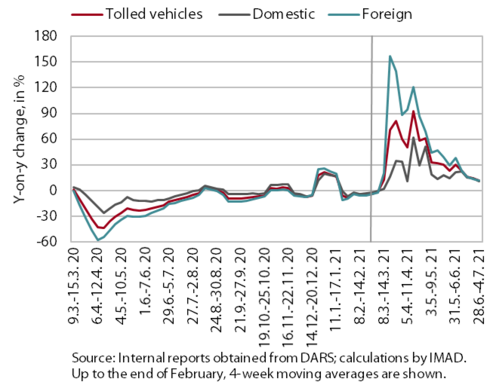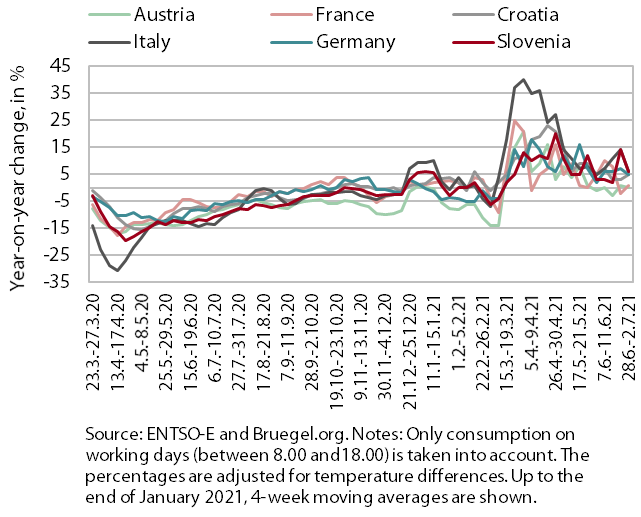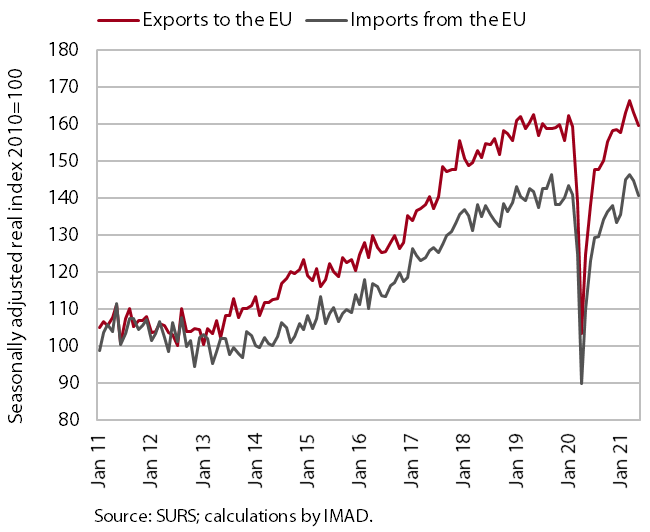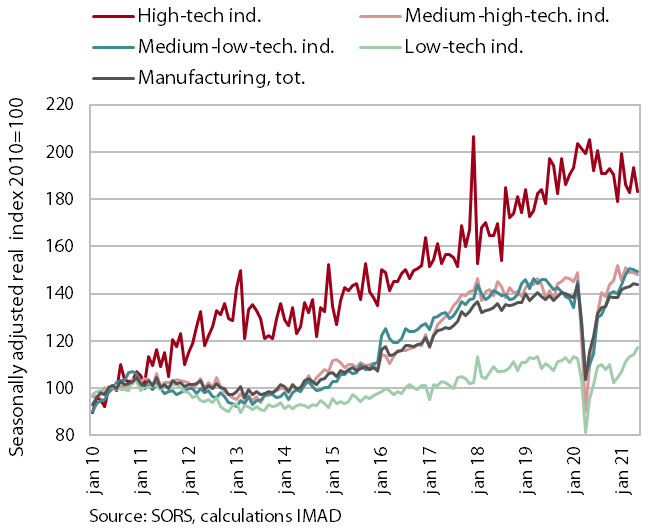Charts of the Week
Current economic trends from 5 to 9 July 2021: traffic of electronically tolled vehicles, electricity consumption, trade in goods and production volume in manufacturing
In May, the volumes of trade in goods and manufacturing production were still well above the comparable pre-epidemic levels. Export expectations improved again in June, and the continued favourable trends in the export-oriented part of the economy at the turn of June and July can also be seen in the volume of freight traffic on Slovenian motorways and in electricity consumption. The volume of freight traffic was significantly higher year-on-year and slightly above the level of the same period in 2019. With a low base last year, electricity consumption was also higher year-on-year, and, compared to the same period of 2019, the gap was slightly smaller than in previous weeks, given the gradual increase in tourism activity.
Traffic of electronically tolled vehicles on Slovenian motorways, July 2021

Freight traffic on Slovenian motorways in the first week of July was 12% higher year-on-year and slightly higher than in the same week of 2019. Freight traffic volumes developed as expected after the start of the summer holidays, with car traffic causing congestion on the motorways, impeding the flow of traffic and higher freight volumes. The significant year-on-year increase is still mainly due to the lower traffic volume in the same period last year after the first wave of the epidemic. Compared to the same week in 2019, the volume of domestic vehicle traffic was 4% higher and the volume of foreign vehicle traffic was 2% lower, but the share of foreign vehicle traffic was about the same as the average share in the pre-crisis year.
Electricity consumption, July 2021

In the week between 28 June and 2 July, electricity consumption was 6% higher than in same week of 2020 but 6% lower than in the same week of 2019. The year-on-year higher consumption was mainly due to the low base last year. However, the gap with the same week in 2019 was slightly smaller than in the previous weeks, mainly due to higher activity in the tourism sector due to the start of the summer holiday. Mainly due to the base effect, year-on-year higher consumption was also recorded in most of Slovenia’s main trading partners (1% in France and 6% in Italy, Germany and Croatia), except in Austria, where it remained the same. Compared to the same week of 2019, all partner countries recorded lower consumption, France by 10%, Italy by 5%, and Austria, Germany and Croatia by 2 %.
Trade in goods, May 2021

Trade in goods fell further in May, but remained higher than last year. Real exports and imports of goods from and into EU Member States have reached levels comparable to those before the epidemic, with significant monthly fluctuations mainly due to changes in containment measures in Slovenia and its trading partners. The growth in exports of goods was interrupted in April and May, which we believe is related to lower vehicle exports and partly to a slowdown in industrial growth in Slovenia’s largest trading partners (Germany, Italy, France). This led to a halt in the growth of trade in intermediate goods. The less favourable development of imports is also related to a somewhat lower level of manufacturing activity in Slovenia. The growth of trade in the first five months of this year remains high year-on-year and is partly due to a very weak activity in April and May last year (the base effect). The outlook remains favourable and is linked to the expected recovery in activity among Slovenia's main trading partners. In June, export expectations improved again and companies were more optimistic about the future foreign demand than before the beginning of the epidemic.
Production volume in manufacturing, May 2021

After several months of growth, manufacturing production fell slightly in May. This was mainly due to the current decline in production in high-technology industries, although production in medium-technology industries also declined slightly. However, production in low-technology industries increased for the sixth consecutive month. Year-on-year, manufacturing production again recorded relatively high growth, although the increase was much smaller compared with the same period in 2019. A high year-on-year growth was recorded in medium and low-technology industries, while a decline was recorded in high-technology industries, although the manufacture of computers, electronic and optical products performed well year-on-year. A high year-on-year growth was also recorded in most major industries, including automotive, which was still far behind the production volumes of the same period in 2019.
